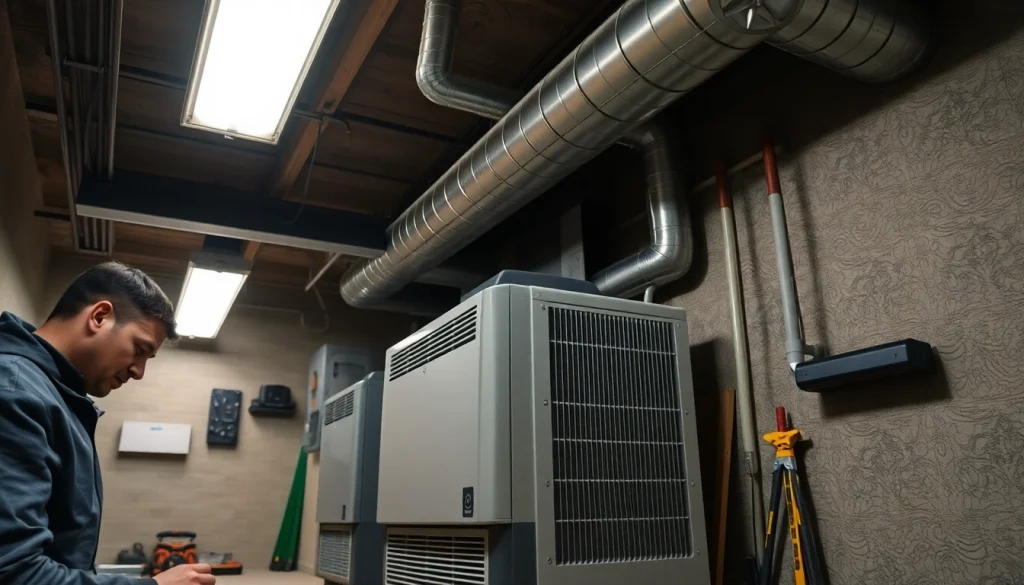Maximizing Comfort: Essential Strategies for Effective Basement Dehumidification

Understanding the Importance of Basement Dehumidification
Basements are often overlooked spaces in a home, yet they play a crucial role in the overall structure and air quality of your living environment. One of the most significant problems that can arise in basements is moisture accumulation, leading to various issues that affect both the longevity of the home and the health of its occupants. This makes basement dehumidification paramount for any homeowner looking to maintain a safe and comfortable living space.
How Moisture Affects Your Home
Moisture can seep into the basement from the ground, through leaks, or due to humidity levels from outside air. The impact of excess moisture includes structural damage, mold growth, and poor air quality. Over time, moisture can weaken the foundation of a home, leading to cracks and other structural issues. Furthermore, mold and mildew thrive in damp environments, which can result in health problems such as respiratory issues and allergies.
The Benefits of Reducing Humidity Levels
Reducing humidity levels in your basement not only protects the structural integrity of your home but also enhances the comfort and health of its inhabitants. Effective basement dehumidification can mitigate issues like musty odors, moisture-related health problems, and damage to personal belongings. Additionally, it can create a more pleasant environment for activities such as laundry or recreational use.
Common Signs That You Need Basement Dehumidification
Homeowners should be vigilant for signs that indicate the need for basement dehumidification. Some common warning signs include:
- Visible mold or mildew on walls and surfaces
- Musty odors emanating from the basement
- Condensation on windows or walls
- Peeling paint or wallpaper
- Wood rot or dampness in any wooden structures
- Frequent allergies or respiratory problems in household members
Choosing the Right Dehumidification System
Types of Dehumidifiers Available
When selecting a dehumidifier, homeowners have a variety of options. Generally, dehumidifiers can be categorized into two main types: refrigerant and desiccant. Refrigerant dehumidifiers are more common and work by cooling the air, causing moisture to condense and drip into a collection bucket. In contrast, desiccant dehumidifiers use materials that absorb moisture from the air and can be particularly useful in colder environments.
Key Features to Look For
Not all dehumidifiers are created equal. Homeowners should look for the following features to ensure they select a model that meets their specific needs:
- Capacity: Measured in pints per day, this indicates how much moisture the unit can remove within 24 hours. Consider the size of your basement to determine necessary capacity.
- Portability: If you plan to move the dehumidifier between areas, ensure it has wheels or handles.
- Energy Efficiency: Look for models with energy star ratings to minimize electricity consumption.
- Automatic Features: Features like auto shut-off, built-in humidistats, and continuous drainage options can significantly enhance convenience.
Evaluating Capacity Needs for Your Basement
Determining the appropriate capacity for a dehumidifier depends on several factors including square footage, moisture levels, and climate conditions. For basements under 1,500 square feet, a unit with a capacity of 30-50 pints may suffice, while larger spaces may require units capable of removing 70 pints or more per day. Additionally, humidity levels that frequently exceed 60% necessitate a higher capacity unit.
Installation Tips for Optimal Basement Dehumidification
Preparing Your Space for Installation
Before installing a dehumidifier, it is essential to prepare your space. This includes clearing out any clutter, ensuring proper drainage for the unit, and considering ventilation. Proper placement can enhance performance. Ideally, position the dehumidifier near the center of the basement and away from walls and obstructions that could impede airflow.
Do-It-Yourself versus Professional Installation
Some homeowners may opt for DIY installation to save costs, while others may choose to hire professionals for peace of mind. Assess your own skills and comfort level with installation to make the best choice. If you opt for a DIY approach, follow the manufacturer’s guidelines closely and ensure you’ve completed each step thoroughly to avoid issues down the line.
Common Mistakes to Avoid During Setup
Common installation mistakes can hinder the efficiency of a dehumidifier. Avoid positioning the unit too close to walls, which can restrict airflow. Ensure that the power supply is adequate, and do not place it in a corner where moisture may collect. Lastly, remember to check the drainage system to ensure it functions as designed, preventing potential water damage.
Maintaining Your Dehumidification System
Routine Maintenance Practices for Longevity
Regular maintenance is key to extending the lifespan of your dehumidifier. Clear the filters and coils at least once every few months, as dust and debris can accumulate and impair function. Also, check the water tank regularly — if your model does not have a continuous drain option, ensure it is emptied frequently to prevent overflow.
Troubleshooting Common Issues
Even the best models can encounter issues. Common problems include the unit not drying efficiently, which can often be remedied by checking the settings or cleaning the filter. If the dehumidifier is making unusual noises, inspect for loose parts or ice buildup on the coils. Always consult the user manual for specific troubleshooting advice related to your model.
Seasonal Adjustments for Maximum Efficiency
Humidity levels can fluctuate drastically with the change of seasons, making it essential to adjust settings on your dehumidifier accordingly. During the more humid months, you may need to set the dehumidifier to run more frequently or at a lower humidity threshold. In contrast, during colder months, settings can be adjusted higher to prevent the unit from freezing.
Monitoring and Evaluating Indoor Air Quality
Tools for Measuring Humidity Levels
To effectively monitor humidity levels in your basement, consider investing in a hygrometer. These devices accurately measure moisture levels and can help you determine when dehumidification is necessary. Ideally, indoor humidity should stay between 30-50% for optimal comfort and health.
Link Between Humidity and Health
High humidity levels are associated with numerous health concerns, including mold-related respiratory issues, allergies, and even increased risk of asthma. Maintaining appropriate humidity levels through effective basement dehumidification can significantly enhance indoor air quality, reducing the potential for health risks among family members.
When to Seek Professional Help for Air Quality
If humidity levels remain problematic despite your best efforts, it may be time to consult professionals. They can conduct comprehensive assessments of your indoor air quality, including checking for hidden mold, moisture sources, and recommending the appropriate solutions that address both humidity and health concerns.






